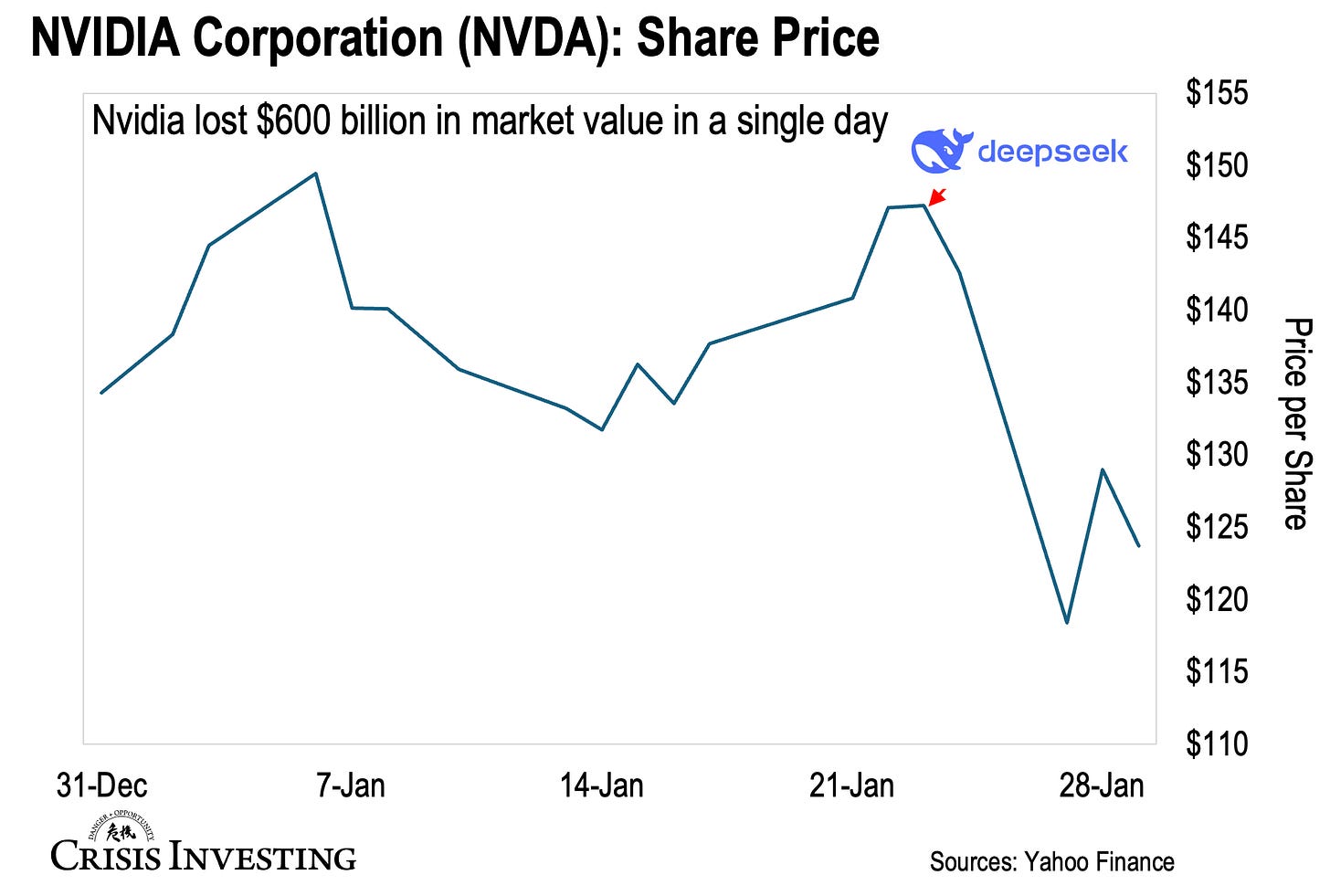Last month, I wrote about the S&P 500 reaching 6,000—the highest it’s ever been in the stock market’s history. Here’s what I had to say:
The “Magnificent 7”—Microsoft (MSFT), Meta (META), Apple (AAPL), Amazon (AMZN), Nvidia (NVDA), Alphabet (GOOGL), and Tesla (TSLA)—now make up a record 34% of the S&P 500’s market cap. That’s more than a quarter. These seven tech darlings are up an average of 70% this year, driving most of the market’s gains. And even that number is skewed by Nvidia’s near-200% surge.
My conclusion was that the market was lopsided and top-heavy, with the “Magnificent 7” dominating and fundamentals out of sight. In short, mainstream stocks looked ripe for a correction.
Keep in mind, this was at a time when Nvidia's market cap had recently surpassed $3.4 trillion, larger than the entire GDP of France.
And, boy, we didn't have to wait long for that correction to hit. It was an absolute bloodbath on Wall Street earlier this week. The Nasdaq plunged 3.1%, the S&P 500 shed 1.5%, and tech stocks across the board were pummeled. This decline wiped out about $1 trillion from the stock market.
And Nvidia? The golden child of the AI chip boom saw nearly $600 billion in market value evaporate in a single day. That’s the largest single-day loss for any public company in history. Take a look at the chart below.
But while I did call the correction—kind of—I never imagined the pin that would burst this bubble would come from a little-known Chinese company.
The Whale Nobody Saw Coming
What happened was that a Chinese research lab called Deep Seek—whose logo fittingly features a whale—released a new large language model that rivals America’s AI crown jewel, OpenAI.
And since OpenAI is so far ahead of the competition, Deep Seek’s model instantly placed itself above nearly all other powerful models on the market.
Imagine an AI that creates entire video games from scratch, using programming languages it barely touched before. Or one that adapts in real time during financial trades and explains its decisions as it goes. Deep Seek AI does all of this—and more.
But that’s not even the wild part. And it’s definitely not the reason U.S. tech companies took such a hard hit earlier this week.
Deep Seek is the product of a $5.6 million investment. That’s millions, mind you—not billions.
This is pocket change compared to U.S. tech giants like OpenAI, which burn through over $5 billion a year (with many more billions poured into development).
When you zoom out, Microsoft, Amazon, Meta, and Alphabet (Google) are pouring over $230 billion a year to dominate the AI space.
And yet, they let a little-known Chinese AI lab slip past them.
Deep Seek’s R1, one of its popular open-source language models, delivers performance nearly on par with GPT-4—and in some cases, it even outperforms it. And it’s more than 30 times cheaper than OpenAI.
It’s also beaten Meta’s LLaMA, OpenAI’s GPT-4, and Anthropic’s Claude 3.5 in various tests, including 500 complex math problems, coding challenges, AI accuracy evaluations, and bug-spotting competitions.
Just this Tuesday, they unveiled Humanity’s Last Exam, a new AI benchmark developed with input from math, physics, biology, and chemistry professors who crafted the hardest questions they could think of. Once again, Deep Seek’s model either topped or matched America’s best. All at just a fraction of the cost.
From Gunpowder to Sputnik
So, where does this leave the U.S. tech titans who’ve bet the farm on AI dominance?
Well, at the very least, they’ve got some tough questions to answer from investors wondering if their massive spending paid off.
If folks start doubting U.S. supremacy in AI, tech stocks could face another wave of pain. NVIDIA might be one of the hardest hit again. And for the average American, that could mean yet another dent in their 401(k) or retirement savings.
But this goes beyond stock market investment implications.
For decades, the U.S. has been the undisputed king of tech innovation, with giants like Apple, Google, Microsoft, Amazon, and OpenAI paving the way. But Deep Seek might just flip that script.
Think about it: despite being cut off from NVIDIA’s top-tier H100 chips due to U.S. sanctions, Deep Seek still found a way. They used the less powerful H800 chips and optimized their training to extract every bit of performance. And in just six months, their progress has been nothing short of astonishing.
Of course, the skeptics are out in full force. Some claim Deep Seek must’ve used OpenAI’s training data. Others doubt they could’ve done it without the best hardware. Maybe, maybe not. But even if both were true, it wouldn’t take away from what they’ve accomplished.
And it’s all open-source. That’s the wildest part. While OpenAI kept their tech locked down, Deep Seek threw open the doors and made their code free for anyone to use.
Now, any geek with a half-decent computer can tap into cutting-edge AI without needing billion-dollar infrastructure or costly cloud services. Barefoot programmers in Calcutta, dorm room visionaries in Minsk—they all have a shot at building something incredible.
It’s like the invention of gunpowder—suddenly, power isn’t confined to the armored elites; it’s in the hands of the masses. This could ignite a tidal wave of innovation, unlocking countless new opportunities, much like the Bessemer Process revolutionized the steel industry and transformed 20th-century America.
In the bigger picture, Marc Andreessen, a legendary venture capitalist and co-founder of Andreessen Horowitz, called this “AI’s Sputnik moment.” And he’s 100% right. Just like the Soviet Union’s satellite launch in 1957 jolted the U.S. into action, Deep Seek is a wake-up call.
It’s clear that China isn’t just closing the gap—they’re positioning themselves to lead. If they scale this tech effectively, it could give them a game-changing edge.
And yes, President Trump just announced $500 billion for Stargate AI, a new initiative in cooperation with OpenAI to secure America’s leadership in AI. But honestly—it already feels like the U.S. is playing catch-up.
Regards,
Lau Vegys




For a long time, many of us knew that computing power was the real war. Now we know for sure!
5 million? Really? Are you sure it wasn't $500 million of smuggled chips? I know the CCP would never lie about anything, but maybe just this once they told a little fib 🤔